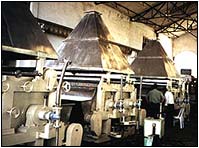Difference between revisions of "Drum Dryers"
(Created page with "Category:Drying{{Knoppen}} <noinclude><!------------------------------------------------ * READ THIS FIRST * Only edit this page if you can improve the content. * Imprope...") |
|||
| Line 5: | Line 5: | ||
* Please start editing this page after the /noinclude | * Please start editing this page after the /noinclude | ||
* -------------------------------------------------></noinclude> | * -------------------------------------------------></noinclude> | ||
[[File:Drum-dryer.jpg|thumb|200px|right|Drum Dryer]] | |||
The Drum drying is a method used for drying out liquids; for example, milk is applied as a thin film to the surface of a heated drum, and the dried milk solids are then scraped off with a knife. Powdered milk made by drum drying tends to have a cooked flavor, due to caramelization caused by greater heat exposure. | |||
Compared to spray drying, drum drying is a more intense heat treatment which results in more denatured proteins. The powder is less soluble as a result. The temperature uniformity of the heated roller/drum is poor so spray drying results in better quality milk powder. | |||
Other products where drumdrying can be used are for example starches, breakfast cereals, baby food, instant mashed potatoes to make them cold water soluble. | |||
===Operating Principle== | |||
The '''Drum Dryers''' are basically a conduction dryer. Wet feed film (in liquid or paste form) is applied to the rotating metal cylinder inside which, a heating medium is supplied. Material film dries to the final moisture level and is scraped off. | |||
===Special Features=== | |||
* Suitable for handling liquid or pasty feeds. | |||
* Product is powdery, flaky form | |||
* Uniform drying due to uniform application of film. | |||
* Medium range capacities. | |||
* Very High thermal efficiency | |||
* Continuous operation | |||
* Compact installation | |||
* Closed construction is possible | |||
===Applications=== | |||
* Calcium Carbonate | |||
* Sodium Benzoate | |||
* Brewer's Yeast | |||
* Calcium Chloride | |||
* Potasium Phenyl Acetate | |||
* Polyacrylamide Gel | |||
* Sodium Acetate | |||
* Dye Intermediate | |||
* Sulphur Black | |||
* Calcium Lactate | |||
* Resis Salt | |||
* Animal Glue | |||
* Barium Sulphate | |||
* Soya Residue (Okara) | |||
* Sodium sulphate | |||
* Acid Voilet | |||
* Pregel Starch | |||
* Distiller's Yeast | |||
* Di- Potassium Phosphate | |||
Revision as of 09:21, 24 July 2012
The Drum drying is a method used for drying out liquids; for example, milk is applied as a thin film to the surface of a heated drum, and the dried milk solids are then scraped off with a knife. Powdered milk made by drum drying tends to have a cooked flavor, due to caramelization caused by greater heat exposure. Compared to spray drying, drum drying is a more intense heat treatment which results in more denatured proteins. The powder is less soluble as a result. The temperature uniformity of the heated roller/drum is poor so spray drying results in better quality milk powder. Other products where drumdrying can be used are for example starches, breakfast cereals, baby food, instant mashed potatoes to make them cold water soluble.
=Operating Principle
The Drum Dryers are basically a conduction dryer. Wet feed film (in liquid or paste form) is applied to the rotating metal cylinder inside which, a heating medium is supplied. Material film dries to the final moisture level and is scraped off.
Special Features
- Suitable for handling liquid or pasty feeds.
- Product is powdery, flaky form
- Uniform drying due to uniform application of film.
- Medium range capacities.
- Very High thermal efficiency
- Continuous operation
- Compact installation
- Closed construction is possible
Applications
- Calcium Carbonate
- Sodium Benzoate
- Brewer's Yeast
- Calcium Chloride
- Potasium Phenyl Acetate
- Polyacrylamide Gel
- Sodium Acetate
- Dye Intermediate
- Sulphur Black
- Calcium Lactate
- Resis Salt
- Animal Glue
- Barium Sulphate
- Soya Residue (Okara)
- Sodium sulphate
- Acid Voilet
- Pregel Starch
- Distiller's Yeast
- Di- Potassium Phosphate
